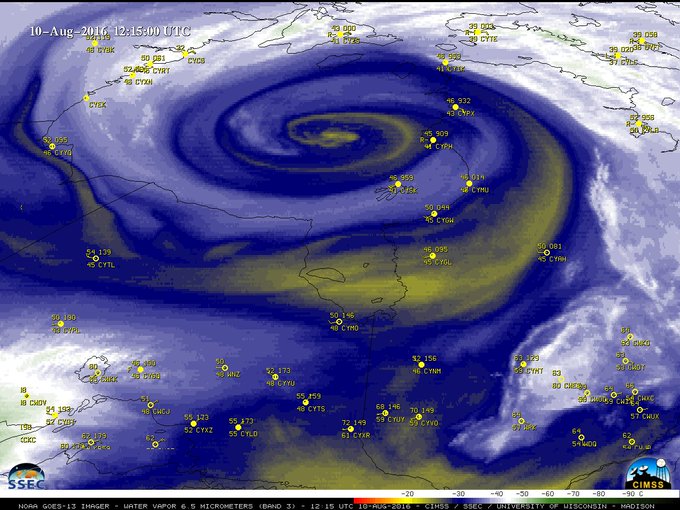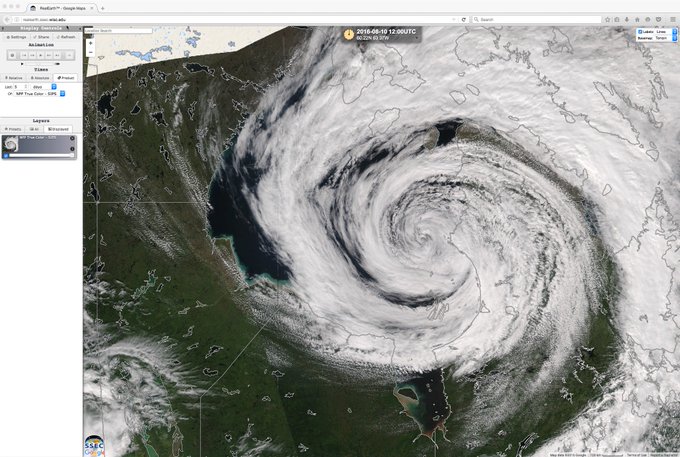Published: August 11,2016
 High-resolution image from the Suomi NPP satellite of North America showing the Hudson Bay, Canada, storm on August 10, 2016.
High-resolution image from the Suomi NPP satellite of North America showing the Hudson Bay, Canada, storm on August 10, 2016.(NASA WorldView)
This extratropical storm intensified Tuesday over Hudson Bay, eventually reaching peak strength Wednesday, before weakening Thursday.
A visible satellite image showed the storm's classic mature phase as a cold occlusion, with relatively cool air completely wrapped around the low center, and a trailing band of clouds ahead of the cold front, resembling an apostrophe or the number 9.
 Visible
satellite image of the Hudson Bay, Canada, storm on August 10, 2016 at
10:45 a.m. EDT, showing the occluded storm's "apostrophe" shape.
Visible
satellite image of the Hudson Bay, Canada, storm on August 10, 2016 at
10:45 a.m. EDT, showing the occluded storm's "apostrophe" shape. Surface frontal analysis, with the Hudson Bay, Canada, storm highlighted, on August 10, 2016, at 2 a.m. EDT.
Surface frontal analysis, with the Hudson Bay, Canada, storm highlighted, on August 10, 2016, at 2 a.m. EDT. (NOAA/NWS)
You wouldn't expect that kind of storm in the Northern Hemisphere in August anyway, as north-to-south temperature contrasts fueling the development of extratropical storms are at a minimum in the heart of summer.
(MORE: Best Weather Photos of 2016, So Far)
Now, let's zoom in on this beauty, starting with a visible satellite loop from Wednesday, Aug. 10.
 Visible satellite loop of the Hudson Bay, Canada, storm on August 10, 2016.
Visible satellite loop of the Hudson Bay, Canada, storm on August 10, 2016. With deep, relatively cool air wrapped completely around the low, you wouldn't expect deep thunderstorms in that circulation.
Therefore, the infrared satellite image shows some interesting structure in the core of the storm, but may not strike you as spectacular as, say, hurricanes or summer's thunderstorm clusters, mesoscale convective systems.
 Infrared
satellite image of the Hudson Bay, Canada, storm on August 10, 2016.
Higher clouds tops are shown by green, yellow and orange shadings.
Infrared
satellite image of the Hudson Bay, Canada, storm on August 10, 2016.
Higher clouds tops are shown by green, yellow and orange shadings.
Deep cyclone over Hudson Bay, Canada http://cimss.ssec.wisc.edu/goes/blog/archives/21709 …
 Water vapor satellite image showing the Hudson Bay, Canada, storm on August 10, 2016, resembling an eye of a face.
Water vapor satellite image showing the Hudson Bay, Canada, storm on August 10, 2016, resembling an eye of a face.(Dundee Satellite Receiving Station/University of Dundee)
This storm's wind field was quite impressive, as shown by the European model analysis from Wednesday morning.
 ECMWF
model surface wind streamline analysis of the Hudson Bay, Canada, storm
on August 10, 2016. The strongest surface winds are indicated by darker
purple streamlines. The low-pressure center is indicated by the hole in
the wind field over Hudson Bay.
ECMWF
model surface wind streamline analysis of the Hudson Bay, Canada, storm
on August 10, 2016. The strongest surface winds are indicated by darker
purple streamlines. The low-pressure center is indicated by the hole in
the wind field over Hudson Bay.Typically, these storms are more common in and near the Lower 48 states from fall through spring, producing snowstorms, high wind events, coastal flooding, even occasionally spawning severe weather outbreaks.
Even by Canadian standards, this was a fairly impressive storm for mid-August.
And it gave meteorologists something to admire.
Jonathan Erdman is a senior meteorologist at weather.com and has been an incurable weather geek since a tornado narrowly missed his childhood home in Wisconsin at age 7.



No comments:
Post a Comment